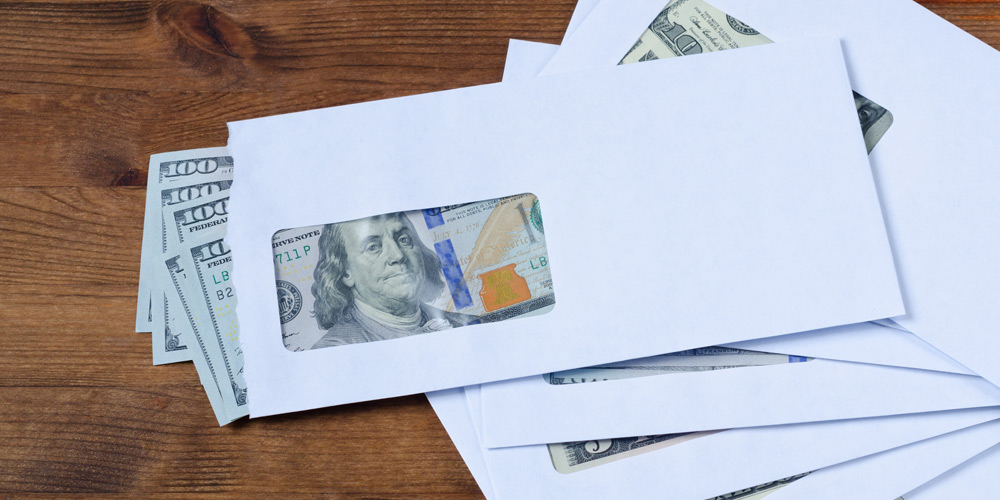Envelope Budgeting: How It Works and Why It Might Be Perfect for You

Have you committed to overhauling your finances only to fall back on old habits? Do you notice that even if you set limits, the temptation to overspend persists?
Maybe you need to try something new.
Envelope budgeting is a simple method to create, and stick to, a budget. It differs from other budgeting systems by taking an old-fashioned, practical approach to money management. All you need are envelopes and cash, and in today’s modern era, the return to basics can be both refreshing and effective.
Interested? Here’s how it works and why you should give it a try.
What is envelope budgeting?
The envelope budgeting system tracks the flow of income and expenses. You place cash in envelopes to track the amount of money you spend in different expense categories each month. At the end of the month, simply check each envelope to know how you did. Extra cash means you came in under budget.
It’s a smart idea to use envelope budgeting to track expenses that typically break the bank. Think about your current budget. Is there a category in which you’re constantly overspending? Dining out? Entertainment? Clothing? Rely on the envelope system’s strict cash-only method to overhaul your budget.
How does envelope budgeting work?
The main reason we overspend is due to a lack of impulse control. There’s often no one holding us accountable to spending limits, except for ourselves. The envelope budgeting system can help. It’s one more financial tool in your arsenal to help you create and stick to a sound budget.
Here’s a step-by-step explanation of how to start:
Step No. 1: Decide on expense categories
Pick which expense categories you want to include in the envelope budgeting process. Identify the monthly expenses that work best with cash. This means they aren’t set up on an automatic payment plan already. Here are a few options:
- Groceries
- Eating out
- Entertainment
- Gas or public transportation
- Clothing, haircare, or makeup
Step No. 2: Determine a spending limit
Determine a spending limit for each expense category you chose in Step No. 1. Look at previous bills, credit card statements, and receipts to determine a realistic amount for each expense. Allocate only the amount needed for each envelope, nothing more. For instance, if you want to reduce your entertainment budget, set a tangible goal, perhaps $20 less than usual.
Determine the number of bills and denominations needed for each of the categories. Then add them up to find your total. Researchers say carrying cash in large denominations may reduce the desire to spend frivolously. It makes sense; think about how tempting it is to spend cash when you have several $1 bills. Take this into consideration when you withdraw cash for the envelopes.
Step No. 3: Divvy up your income and put cash into the envelopes
Choose an envelope or similar receptacle to store dollars and cents for each expense category identified in Step No. 1. Label the envelopes. Each time you receive a paycheck, withdraw cash from your financial institution. Withdraw the total amount of cash identified in Step No. 2. Fill each envelope with the correct amount of cash to stay within your spending limit.
For example, your breakdown might look like this:
- $200 for the grocery budget envelope
- $80 for the public transportation budget envelope
- $50 for in the entertainment budget envelope
Now each time you leave the house to make a purchase, make sure you bring the relevant expense envelope. If you have $100 left in the grocery budget envelope, then your cart shouldn’t total any more than the $100. If it does, take items out of your cart or look for cheaper alternatives to stay within budget. Apply this strategy to each of your expense categories.
Only use cash from the correct envelope for each expense category. Take it a step further, by removing your debit and credit cards from your wallet. This way you are forced to rely on the cash you carry.
Step No. 4: Account for online purchases
Envelope budgeting works best when you spend money in person. This means walking into a physical store and exchanging cash with the salesperson.
When you complete online purchases, it makes things trickier, but it’s still doable.
Write the amount you budgeted on the outside of each envelope. Update the number to reflect the current amount of cash in the envelope. Slash the number when you spend cash. Refer to the updated total before you purchase an item online. Make sure that you don’t spend more online than the amount written on the envelope. Once you make an online purchase, update the total on the envelope and remove cash from the envelope just like it’s an in-person transaction. Deposit the cash back into your bank account.
Step No. 5: Don’t spend when your envelope’s empty
The most important rule for the envelope budgeting system is this: When your cash runs out, it’s gone. Not forever, just until the next month.
Further, ensure that you don’t borrow cash from other envelopes. It’s tempting to shuffle money between the envelopes to fund one category from another. But that defeats the purpose. Remember why you must stick to the rules — to take control of reckless spending and create a new budgeting system.
If you run low on cash before the end of the month, find a creative way to stretch your money. Instead of dining out, cook a meal. Instead of buying a movie ticket, rent a free movie at home.
It might be hard, but stick with it. The envelope budgeting system will overhaul your bad spending habits. But only if you commit to not busting your budget.
Step No. 6: Reallocate the remaining money
Do you have cash left over at the end of the month? That’s great! You came in under budget. Reward your hard work with a reasonable treat, but don’t get carried away.
Another option is to reallocate the remaining money. Roll it into next month’s envelope to create an extra-large budget. Use the extra money to pay off debt. Or consider saving the extra money or investing it. These are all good options that will improve your financial health in the long run.
Is envelope budgeting right for me?
There are two great strengths to the envelope budgeting system:
- First, it’s a simple budgeting method. Place a predetermined amount of cash into an envelope. Only use cash throughout the month to pay bills for each expense category. Easy, right?
- Second, it’s impossible to overspend, so long as you stick to the rules. Only use cash from the appropriate expense envelope - no dipping into the grocery fund for entertainment expenses. Once cash runs out, that’s it. This is a great option for people who need a reality check when it comes to overspending and rising debt.
Here are other pros and cons of envelope budgeting.
Pros
- Simplicity. It’s a simple system that doesn’t rely on apps, math, or online banking.
- Experiential. It’s best for visual and kinetic learners. Compared to credit cards, handling cash in an envelope is a tangible learning experience.
- Spend less. It relies on a limited amount of cash, which curbs overspending and debt.
- Discipline. It fosters discipline to limit spending beyond the cash in each envelope. This creates accountability and better long-term financial habits.
Cons
- Tricky. If you must factor in online spending or automatic bill pay, then it might be trickier to adhere to only spending the cash in the envelopes.
- Discipline. It relies on a high level of discipline and self-accountability, otherwise, the method will fail.
- Security. If you carry cash, be careful it’s not lost or stolen.
More tips to make it work
We spoke to Larry Duffany, a financial coach at Raising Hope, about his suggestions for how to use the envelope budgeting system.
Duffany uses envelope budgeting for immediate expenses, but he also uses them for sinking funds, such as vacations, car repairs, and taxes. A sinking fund is a strategic way to save for future costs by setting aside money each month.
He also suggests for anyone who is self-employed to create an envelope for a hill-and-valley fund. A hill and valley fund prioritizes saving money to cover months when your paycheck is smaller than anticipated. The fund helps pay fixed expenses without tapping into an emergency fund or other savings.
“I make sure that I have money in [the hill and valley fund] to level the valley (dip in income) by taking the excess (hill) over what I normally have (average income) so that my income over those months is normalized,” Duffany says. “I highly recommend this fund for anyone who is self-employed with an irregular income.”
Bottom Line
Envelope budgeting is a powerful tool to combat overspending and reduce debt. Try intentional budgeting by making the envelope system work for you.

Larry Duffany is a master financial coach and a career educator at Raising Hope. Combining financial lessons with his training and experience as a high school teacher and adjunct college professor, Duffany walks alongside his clients raising hope for a better tomorrow. His goal is to move his clients from surviving to thriving by changing their money habits one day at a time.
Please note the below article contains links to external sites outside of OppU and Opportunity Financial, LLC. These sources, while vetted, are not affiliated with OppU. If you click on any of the links you will be sent to an external site with different terms and conditions that may differ from OppU’s policies. We recommend you do your own research before engaging in any products or services listed below. OppU is not a subject matter expert, nor does it assume responsibility if you decide to engage with any of these products or services.




